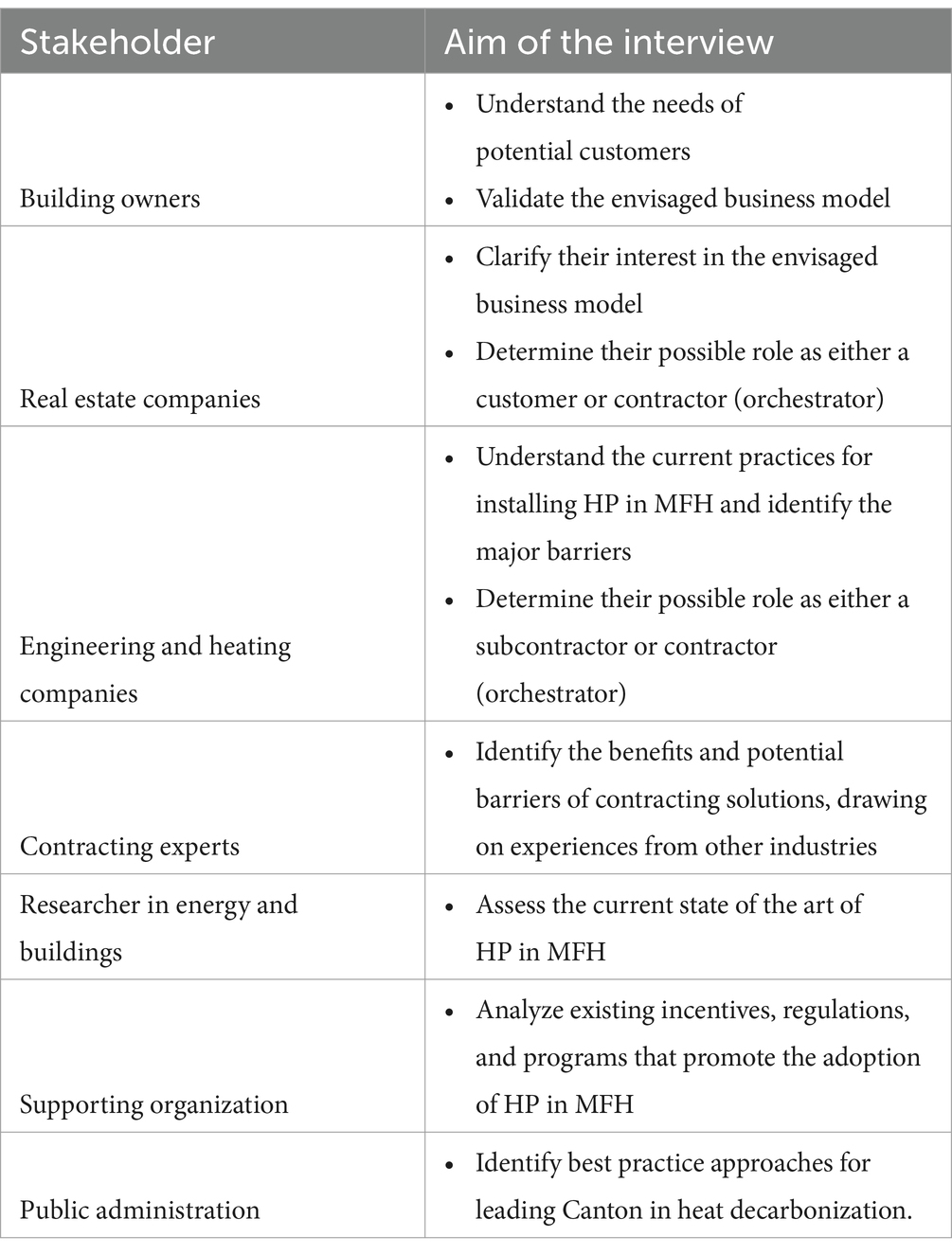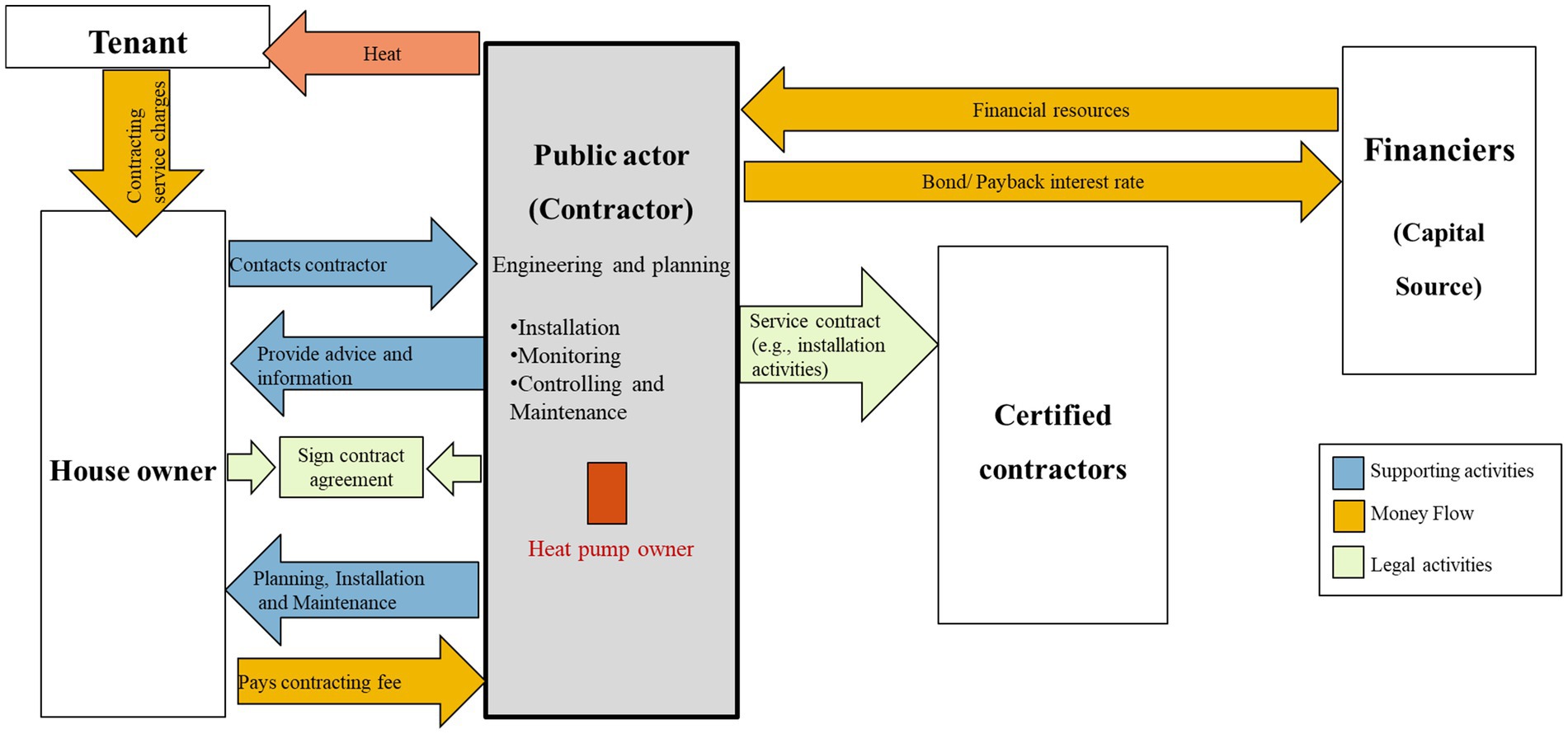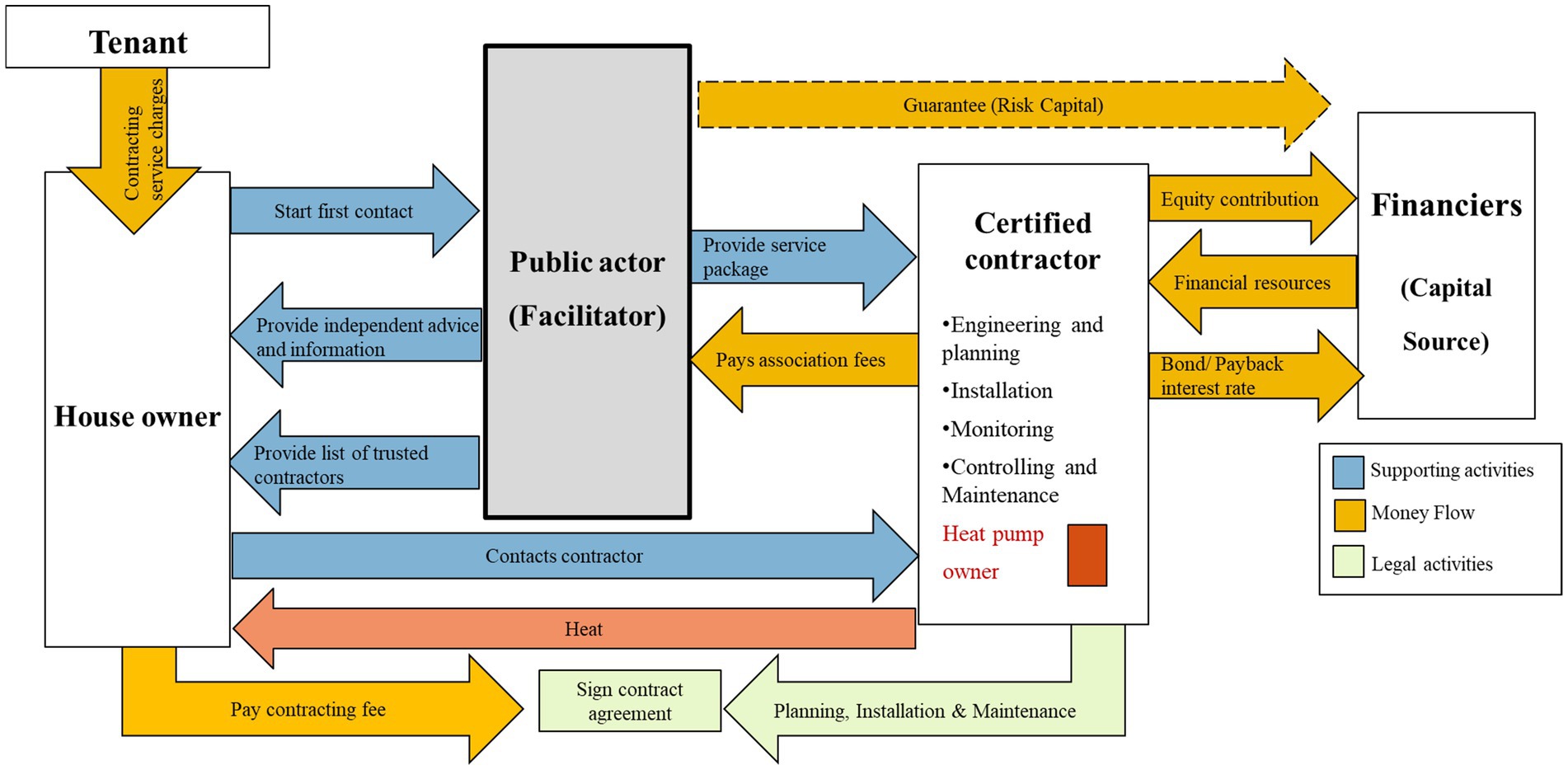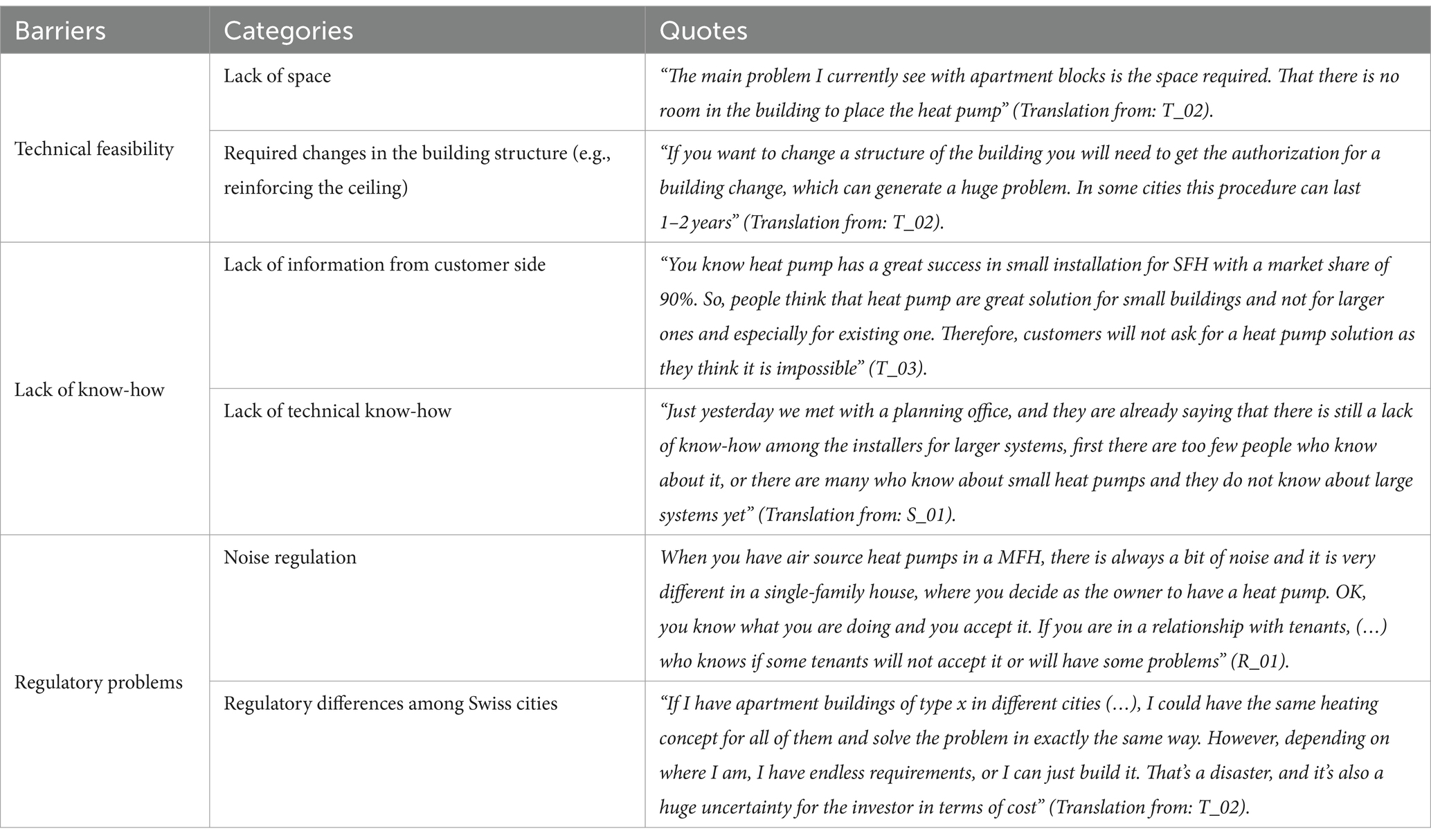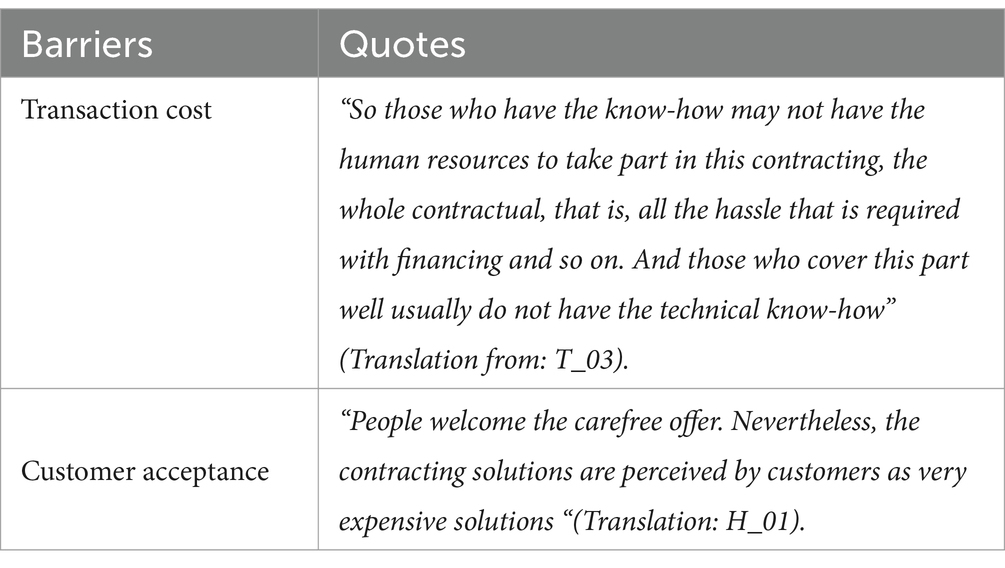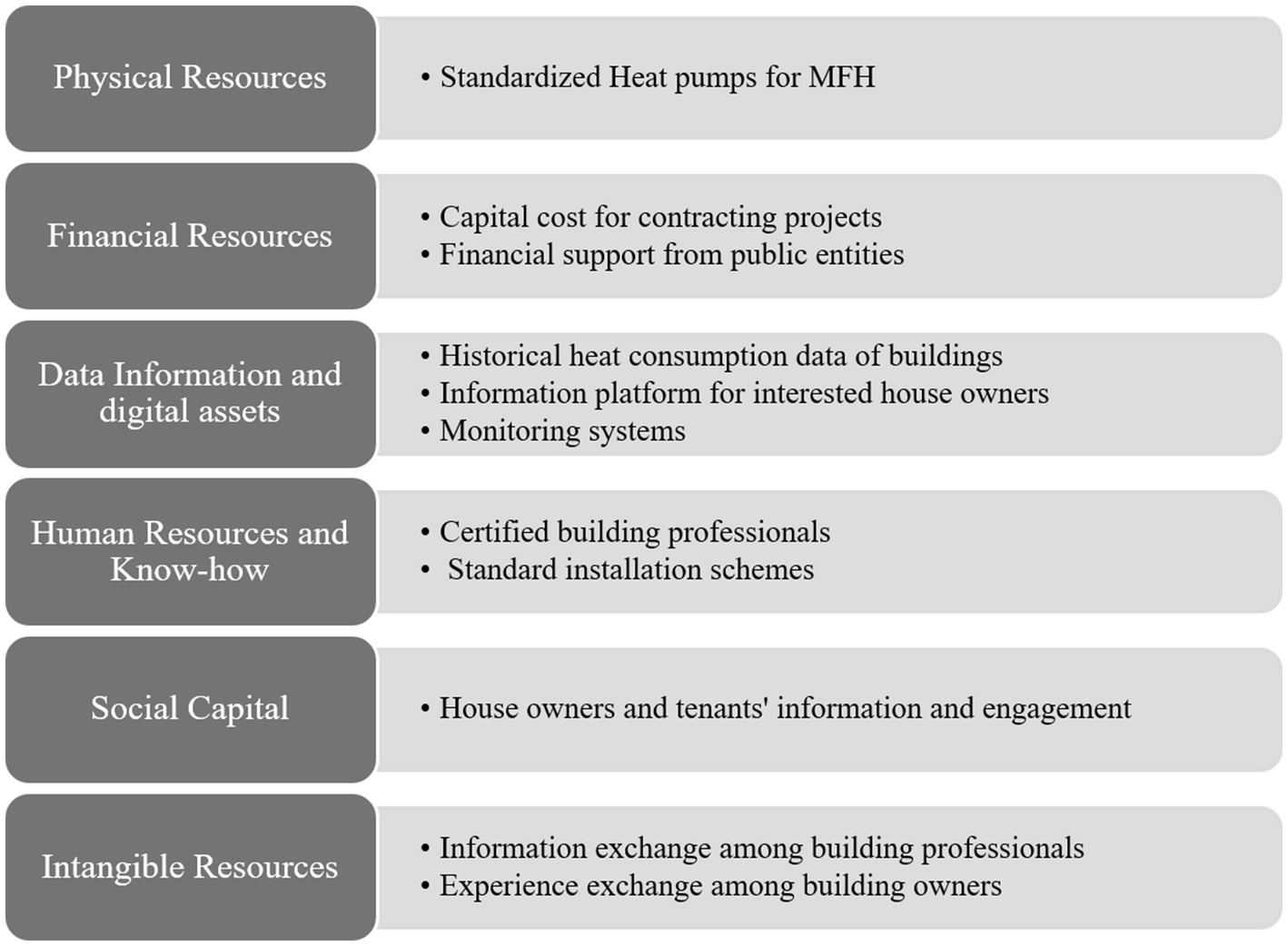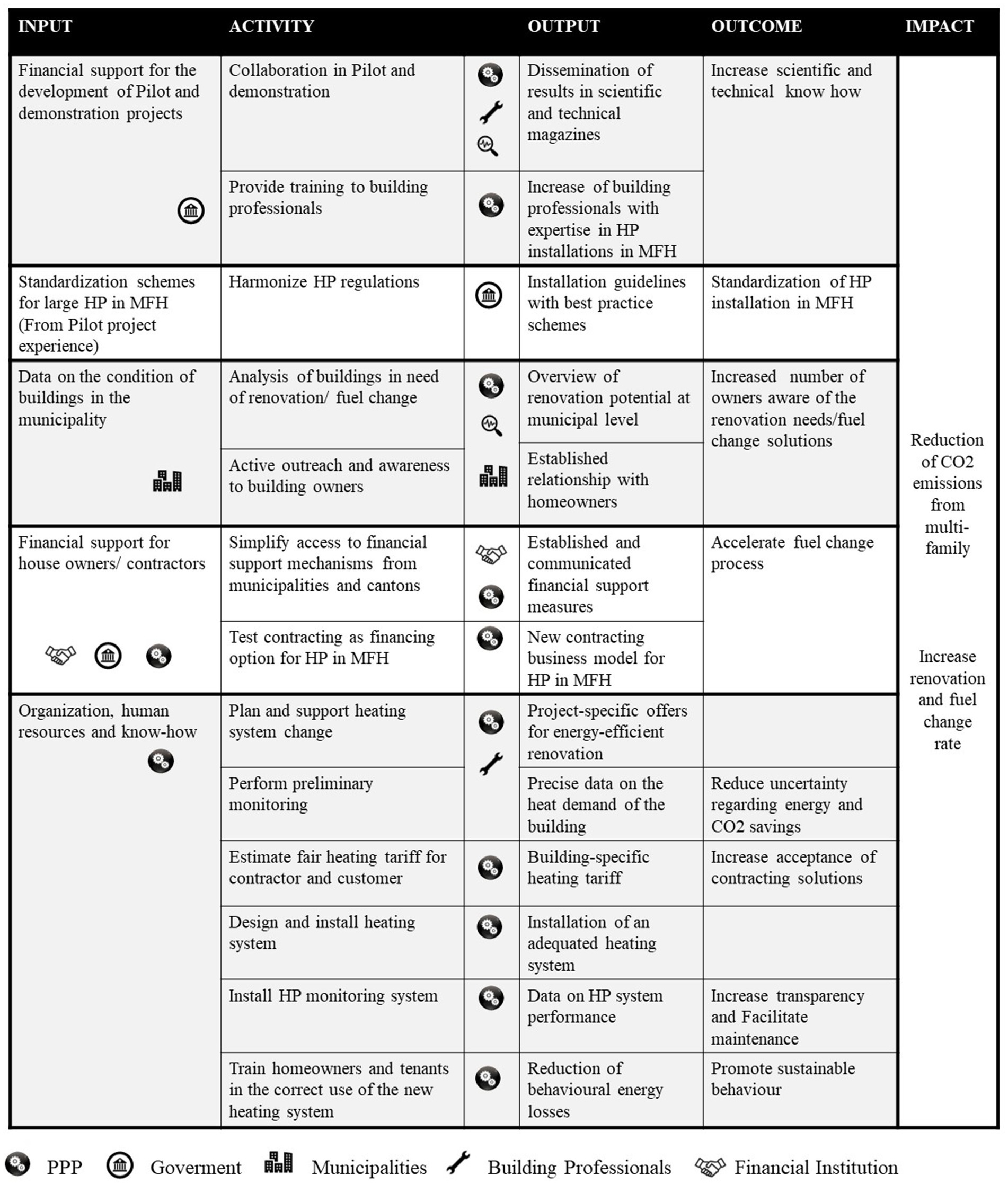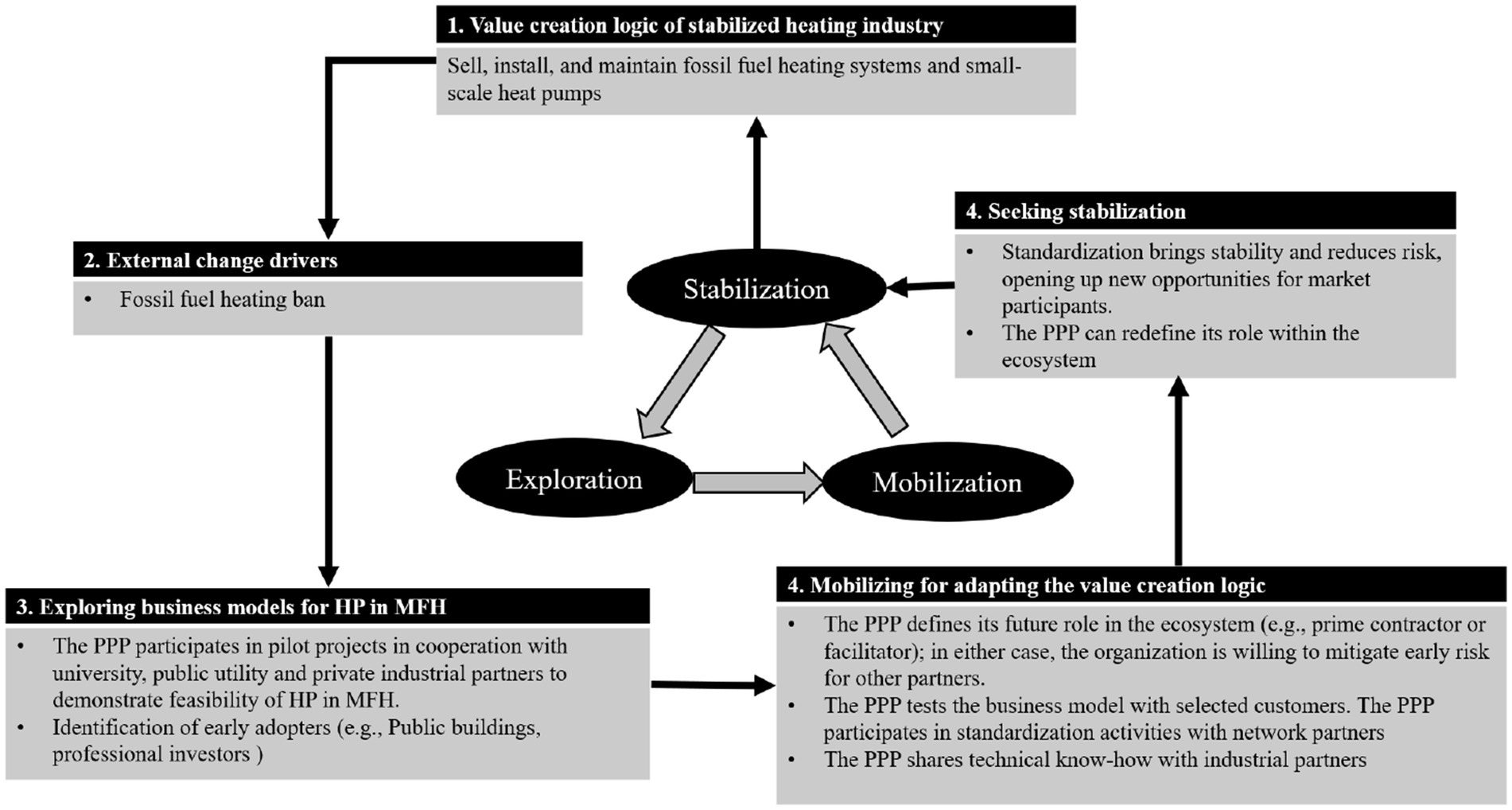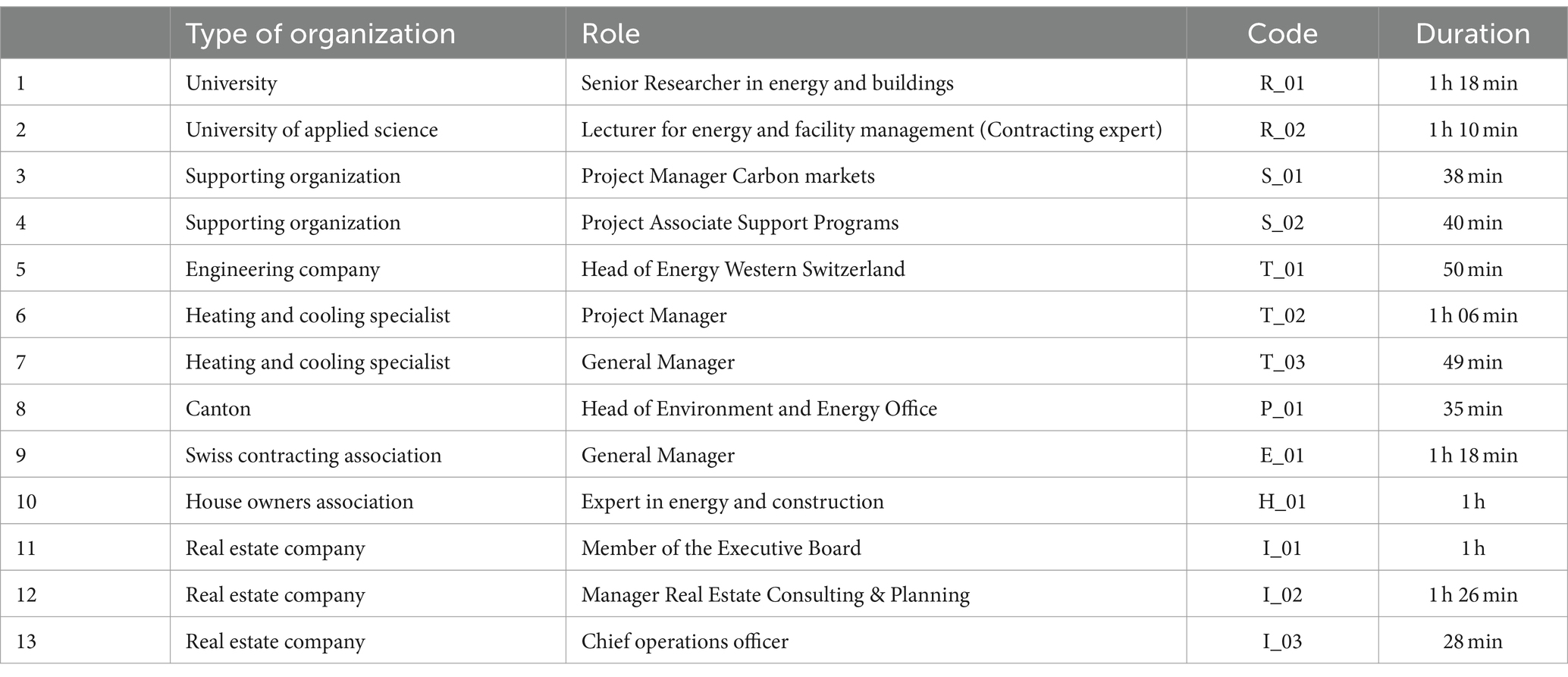- 1Institute of Sustainable Development (INE), Zurich University of Applied Sciences ZHAW, Winterthur, Switzerland
- 2Lucerne School of Business, Institute of Business and Regional Economics, Luzern, Switzerland
Introduction: In Switzerland, heating accounts for 70% of a building’s energy consumption, mostly fueled by fossil sources. Recently, cantonal regulations have mandated the use of renewable energy in heating, making heat pumps more significant. This study examines how public and private actors can create or transform a business ecosystem to facilitate heat pump adoption in multi-family houses and which business models, resources, and activities are most effective to support this transformation.
Methods: We conducted a literature review and 13 semi-structured interviews with experts in heat pumps and contracting business models. The interviews were analyzed using an ecosystem framework.
Results: Our findings revealed three primary barriers to the adoption of heat pumps in MFHs: technical challenges, lack of expertise, and regulatory issues. In terms of contracting business models, high transaction costs and customer acceptance are significant obstacles. Additionally, we discovered that in Switzerland, contracting is predominantly offered by public-oriented organizations with ready access to capital.
Discussion: The study emphasizes the necessity for collaboration among various actors to facilitate the implementation of contracting solutions with the goal of accelerating the adoption of heat pumps in multifamily housing. Key activities include generating the necessary expertise and standardizing large heat pumps in MFHs, central government efforts to harmonize and facilitate HP regulations across cantons, as well as active communication and sensitization of building owners and users.
1 Introduction
In Europe, around 40% of energy consumption and 36% of energy-related greenhouse gas emissions are attributed to buildings (European Commission, 2020). In Switzerland, heating accounts for around 70% of a building’s energy consumption mostly fueled by fossils (BFE, 2023). Therefore, as part of its Energy Strategy 2050, the Swiss government aims to switch from the current predominance of fossil fuels for heating to renewable alternatives.
In recent years, most cantons have introduced strict regulations that either ban the installation of fossil fuel heating systems in new residential buildings or at least require a minimum percentage of renewable energy for heating (Perch-Nielsen et al., 2023).
In this context, heat pumps are becoming increasingly important. Based on Swiss statistics, the proportion of buildings with heat pumps has quadrupled since 2000. This applies in particular to newly built properties and single-family houses (FSO, 2023).
However, as mentioned by several authors (Fraga et al., 2018; Lehmann et al., 2023; Perch-Nielsen et al., 2023), the replacement of fossil-based heating technologies with renewable technologies using air-to-water heat pumps in multi-family houses (MFHs) has been slow due to a series of technical, economic, and regulatory barriers. Reaching this market is critical to decarbonization, as MFHs account for the largest residential heating demand in Switzerland (Montero et al., 2022).
As part of the Flagship initiative RENOWAVE, our research aims to explore the barriers that hinder the adoption of heat pumps in MFHs and identify possible measures to accelerate this process. Considering the complexity of this problem, we adopt the ecosystem framework developed by Speich and Ulli-Beer (2023) to answer the following research questions: How can public and private actors create or transform a business ecosystem to facilitate the adoption of HP systems in MFHs? Which business model designs, resources and activities are most helpful to perform this transformation?
We approached these questions through a review of existing literature and primary data collected from 13 interviews. This article is structured as follows: Section 2 summarizes the literature review regarding barriers to the adoption of HPs in MFHs and provides an overview of the different business models for heat pumps. Afterwards, we describe the analytical framework and our data acquisition and analysis procedures in Section 3. We present the results in Section 4 and afterwards, we use the ecosystem perspective to frame the discussion in Section 5 and finally, we summarize the work and make recommendations for further research in Section 7.
2 Literature review
2.1 Barriers to the adoption of heat pumps in MFH
There is extensive literature on the barriers to heat pump adoption. The high investment cost is one of the main constraints to the uptakes of heat pumps in residential buildings (Côté and Pons-Seres de Brauwer, 2023; Lehmann et al., 2023; Perch-Nielsen et al., 2023; Pezzutto et al., 2017; Trier et al., 2018). Although heat pumps have low operating costs, the high upfront cost required to buy and install remains a major barrier.
Furthermore, the lack of know-how was often cited as a significant obstacle. On the one hand, heat pump technologies are often not familiar to the homeowners, who make the final decision (Pezzutto et al., 2017; Trier et al., 2018), this can lead to a lack of confidence in the technology. On the other hand, building professionals often lack experience of best practice in HP design and installation (Perch-Nielsen et al., 2023; Pezzutto et al., 2017; Trier et al., 2018).
The particular case of heat pumps in MFHs faces further challenges, such as: (1) split incentives between building owners and tenants, (2) location in densely populated urban areas, where renewable heat sources apart from ambient air are scarce, (3) strong noise regulations, (4) structural constraints of the building and lack of space for the HP or its heat exchanger (Cozza et al., 2022; Fraga et al., 2018; Lehmann et al., 2023; Montero et al., 2022).
This results in even higher investment costs and risks for this type of projects. According to a verbal communication with our implementation expert, based on their field experience of recent projects in the last 2 years, the installation of an air-to-water heat pump in a non–renovated MFH costs approximately between 3,000 and 4,000 CHF/kW, which includes roughly 1,000 CHF/kW for the cost of the heat pump, 1,000 CHF/kW for the cost of piping and related heating equipment, 1,000 to 2,000 CHF/kW for ancillary costs including reinforcement of the electrical network, sound insulation, architectural integration and piping on the facade/inside the building. This last point varies greatly depending on the complexity of the project. As consequence, although the amount of heat pumps installed in Swiss residential building is steadily increasing, the installation rate in MFHs is lower than in single-family houses or newly renovated buildings (Farsi et al., 2022). Nevertheless, as mentioned by several authors (Lehmann et al., 2023; Montero et al., 2022; Perch-Nielsen et al., 2023) the decarbonization potential in MFHs is large, as they represent around 45% of the heated area in Switzerland.
Based on this multifaceted problem situation, involving high risks and costs without a one-size–fits–all turnkey solution, we argue that the existing HP business environment needs to be transformed, to accelerate the adoption of HP in MFH, in order to align public goal with business goals in a competitive business environment. Therefore, public private partnerships and innovative business model designs such as contracting business models become relevant.
2.2 Contracting business models in the HP market
As stated in (Freyre et al., 2021; Kircher and Zhang, 2021), in the current heat pump business model, the house owner gets in contact with an installer who designs and installs the heating system. Government subsidy may be available to the house owner to reduce the upfront cost. During the operation, the user pays for the electricity that the HP consumes and for any needed maintenance.
Other business models, mainly offered by Energy Service Companies (ESCO), exist but are less developed in the heat pump market. Two main types of ESCO business models can be identified: Energy performance contracting (EPFC) and energy supply contracting (ESC). In the ESC business model, the contractor guarantees the supply of energy and is responsible for the financing, operation and maintenance of the energy system. In contrast, in the EPFC business model the contractor not only supplies the energy but finances the energy system with the income from energy cost savings (Pätäri and Sinkkonen, 2014).
According to several scholars (Brown et al., 2022; Kircher and Zhang, 2021) such business models might promote the heat pump adoption in MFHs by addressing the significant obstacle posed by the high upfront costs. Furthermore, contracting offers a way of dealing with the problem of split incentives for landlords and tenants. According to the Swiss ordinance, if the landlord obtains heating energy from a central source that is not part of the property, he has the right to charge the tenant for the actual costs of obtaining and providing the heating energy (VMWG, 2020).
However, the implementation of contracting business models faces several challenges such as, incompatible legal frameworks, significant risk for the contractors and the lack of adequate mechanisms for the financing of ESCO contracts, as well as a lack of customer awareness and trust (Boza-Kiss et al., 2017; Brown et al., 2022; Pätäri and Sinkkonen, 2014).
As mentioned by different authors (Britton et al., 2021; Wan et al., 2023) a service provider assumes several risks when providing contracting solutions. Financial risk is associated to the default risk (risk that the house owner fails to make timely payments). Design risk appears when there is a difference between the expected and actual performance of the system. Technical risks relate to technical aspects of installed equipment and personnel skills. Economical risk which refers to the fluctuation of macroeconomic aspects such as the exchange rate, the interest rate and fuel price. Regulatory risk encompasses a volatile and complicated political framework. Finally, behavioral risk relates to the impact of the consumer behavior on the actual performance of the system (Britton et al., 2021; Koutsandreas et al., 2022; Wan et al., 2023).
To reduce this risk, ESCOs have focused on specific market segments, grouping users with similar needs and providing them with standardized solutions. Such as lighting systems for large energy users (Backlund and Thollander, 2011; Klinke et al., 2017). Therefore, several authors advocate for a rethinking of this business model (Côté and Pons-Seres de Brauwer, 2023; Pätäri and Sinkkonen, 2014), opening a new research avenue to investigate variants of contracting solutions that increase its diffusion and acceptance in riskier and less standardized market segments.
2.3 The concept, formation, and transformation of business ecosystems
Based on the previous section, it can be concluded that the commercial attractiveness of heat pumps in non-renovated MFHs is rather low due to the high upfront costs and associated risks. Nevertheless, heat pumps remain key elements in achieving the decarbonization targets set by public authorities.
This results in conflicting goals between the private sector, which is looking for economic viability, and the public sector. In order to align these goals, cooperation is needed, which can take the form of a public-private partnership (PPP). Our aim is to explore variants of organizational designs of such a PPP and to examine the activities and resources required, with a particular focus on the role of public actors. Therefore, we adopted an ecosystem perspective that focus on value creation and systemic synergies between distinct actors.
The ecosystem metaphor was initially derived from biological systems and subsequently introduced into the field of business studies by Moore (2006), who defines the business ecosystem as an economic community of actors that interact and co-evolve with each other and with their environment.
To examine the dynamics of the business ecosystem in the context of a low-carbon transition, Speich and Ulli-Beer (2023) developed a framework applying a co-evolutionary business ecosystem perspective (CEBEP). The CEBEP framework, conceptualizes how actors of a value network should synchronize to pursue a common goal. The main ecosystem actors are the orchestrator, who coordinates the entire ecosystem; the value network with the core partner, who provides the services and products to deliver the value proposition; and the customers. Key activities encompass the coordination of a shared Resource Pool for the Value Network and cooperation with the broader Business Environment (such as engagement with Policy and Politics). The transformative outcomes include innovations in the business model, a more proficient utilization of resources, and ultimately, a competitive Value Network that delivers sustainable value propositions for customers in support of public interest.
Furthermore, Möller et al. (2020) suggest that changes in the business environment such as the advent of new technological innovations precipitates the formation and transformation of business ecosystems. They posit that this process unfolds in three distinct phases: exploration, mobilization, and stabilization. During the exploration phase, the objective is to gain an understanding of the potential innovation by acquiring strategic knowledge. This phase also involves the identification of stakeholders and early adopters and their prioritization (Van Bockhaven and Matthyssens, 2017).
In the mobilization phase, an initial business network is established. The orchestrator’s role is to motivate strategic partners to participate in the ecosystem. This can be achieved by making significant investments to mitigate the risk of other partners and thereby making participation in the ecosystem more attractive (Shen et al., 2024).
Finally, the stabilization phase entails consolidation and expansion of the ecosystem. This phase will ultimately result in a greater number of players entering the market. This will require a reconfiguration of the ecosystem, via reevaluation of the role of the orchestrator and the business ecosystem (Koskela-Huotari et al., 2016).
Based on the described theoretical background, the objective of this paper is to explore the potential for public and private actors to create or transform a business ecosystem to facilitate the adoption of HPs in MFHs. The business ecosystem for small residential HPs is already established and functioning well, but to promote HPs in MFHs, a new ecosystem needs to be formed or the old one transformed to overcome the barriers. Within this context, we will analyze how energy supply contracting can support the ecosystem (trans)formation in the early phases of exploration and mobilization.
3 Methodology
This study applies a qualitative methodology that is most adequate to collect the required details to differentiate and evaluate distinct variants of Public Private Partnership configurations. The methodological approach is illustrated in Figure 1. In the initial phase, we conducted desk research to deepen our understanding of the challenges associated with heat pump adoption in MFHs and to inform the discussion on how public and private stakeholders can create or transform a business ecosystem to help to overcome these challenges.
Afterwards, we identified the key public and private stakeholders of our business ecosystem which are listed in Table 1.
We used the value network analysis to describe and visualize the roles and relationships of the key ecosystem actors, considering not only the financial exchange but other kinds of values such as knowledge or intangible benefits (Lewrick, 2022). We did this for two different contracting business model variants, i.e., contracting and facilitation, which, according to our project partners, have the greatest potential for implementation.
We then conducted expert interviews to validate the literature findings, look for barriers and challenges for the two business models under investigation and understand the possible role of the stakeholders in the business ecosystem (orchestrator, core partner or customer). The data collection was performed via semi structured interviews with representatives of the identified stakeholder groups. To improve the quality of the interviews the guidelines were sent in advance to the interviewees.
Following the grounded theory methodology, the interview guidelines were adapted to dig on the previous findings and to meet the expertise of the different actors. Table 1 explains the purpose of the interview for each stakeholder group. After analyzing 13 interviews, we reached theoretical saturation. The interviews were transcribed and analyzed using the software MAXQDA. A mixed open coding process was performed, using the categories of the CEBEP framework and generating new design and evaluation categories.
Based on the insights of the literature review and the interviews, we performed a complete analysis of the business ecosystem on HPs for MFHs. We combined the CEBEP framework with the business ecosystem design principles described in Lewrick (2022) to illustrate the business ecosystem.
We analyzed the public and customer value proposition and the role of the orchestrator. Afterwards, we mapped the necessary common resources required for the successful operation of the contracting solutions.
Furthermore, as suggested by Mattos et al. (2022) we used the theory of change (ToC) to show how the interaction between stakeholders can generate and transform the necessary resources. According to the theory of change, the project’s impact is the expected overarching societal goal, the outputs represent the concrete actions devised within the project to contribute towards realizing this impact. Whereas outcomes go beyond the project and include the concrete changes that result from the development of the project. Therefore, the advantage of the ToC is that it helps to create a plan to achieve an overarching goal; this plan consists of a pathway of actionable activities that have the potential to bring about the desired intermediate and long term outcomes (Claus and Belcher, 2020).
Additionally, we used the framework developed by Laakkonen et al. (2023) and Möller et al. (2020) to describe the different phases of ecosystem transformation, thereby facilitating the understanding of this dynamic process and the identification of necessary activities to promote it.
4 Results
4.1 Case study description and value network analysis
This work has been developed in cooperation with a large public utility of Switzerland. This utility has significant responsibilities in the heat decarbonization of its region. Committed to advancing the adoption of heat pumps in MFHs, they have actively participated in various pilot and demonstration projects. One of its objectives is to evaluate how contracting business models for HPs in MFHs sector, could help to mitigate the high perceived technological and financial risk and thus contribute to the (trans)formation of the business ecosystem.
Furthermore, they are seeking to support the diversification and increase the participation of private actors through market-based collaboration measures which can take the form of public-private partnerships. A better understanding of the structure of the PPP, the role of the public actor and the activities that various stakeholders, need to carry out would help them to actively support the ecosystem transformation in order to promote the uptake of heat pumps in non-retrofitted multi-family houses (MFHs).
Based on the literature review and expert discussions, we have identified different roles that the public actor can play in a PPP considering distinct contracting business model designs. The two most interesting business model design variants (i.e., contractor- and facilitator business models) are explained below:
4.1.1 Public actor as contractor
In this case, the energy supply contracting business model is offered by the public actor (e.g., Energy utility company). As illustrated in Figure 2, the public actor will be responsible of the entire value chain from design, purchasing, installation, monitoring and maintenance and will retain the ownership of the heat pump. The private sector may contribute to these activities by providing services, such as installation, under contractual agreement.
This is the most common form of energy contracting in Switzerland, where few public oriented organizations operate this type of business. The main strength of this variant is the easy access to capital, while the high financial and technical risk remain main barriers for the public actor.
4.1.2 Public actor as facilitator
In this case, the main objective of the public actor is to ease access to capital for private actors who may want to compete in the heat contracting market. Financial institutions frequently impose rigorous requirements for loans related to contracting projects, including the need for significant equity capital, which may not be accessible to private investors. A public guarantee could assist in mitigating the financial institution’s risk perception, thereby improving the lending conditions. Figure 3 illustrates the main interactions between house owners, the contractors as well as financial institution that are facilitated by the PPP.
An example of such a variant is provided by the Energy Efficiency and Renewable Sources Fund (EERSF), which operates in Bulgaria as a commercially oriented public-private finance facility, whose activities include the provision of partial credit guarantees, which are recognized as first-class collateral equivalent to bank guarantees (Vanstraelen et al., 2015).
4.2 Expert interviews
To examine success factors and validate the practicality of the two contracting business model designs mentioned above, we performed expert interviews. The focus is on understanding the needed resources for the success of contracting HPs in MFHs, as well as the needed activities to develop these resources. More specifically, the interviews provide insight into two main areas:
• Qualitative assessment of the development of the HP market in MFHs, highlighting barriers and opportunities for this development.
• Qualitative assessment of the attractiveness of energy supply contracting and facilitator business model for HPs in MFHs.
A complete list of the interviewees can be found in the Annex (Section 11) of this publication.
4.2.1 Heat pump market development
First, we looked at the perceived barriers for the development of the heat pump market for MFHs. We have identified several categories of barriers as illustrated in Figure 4.
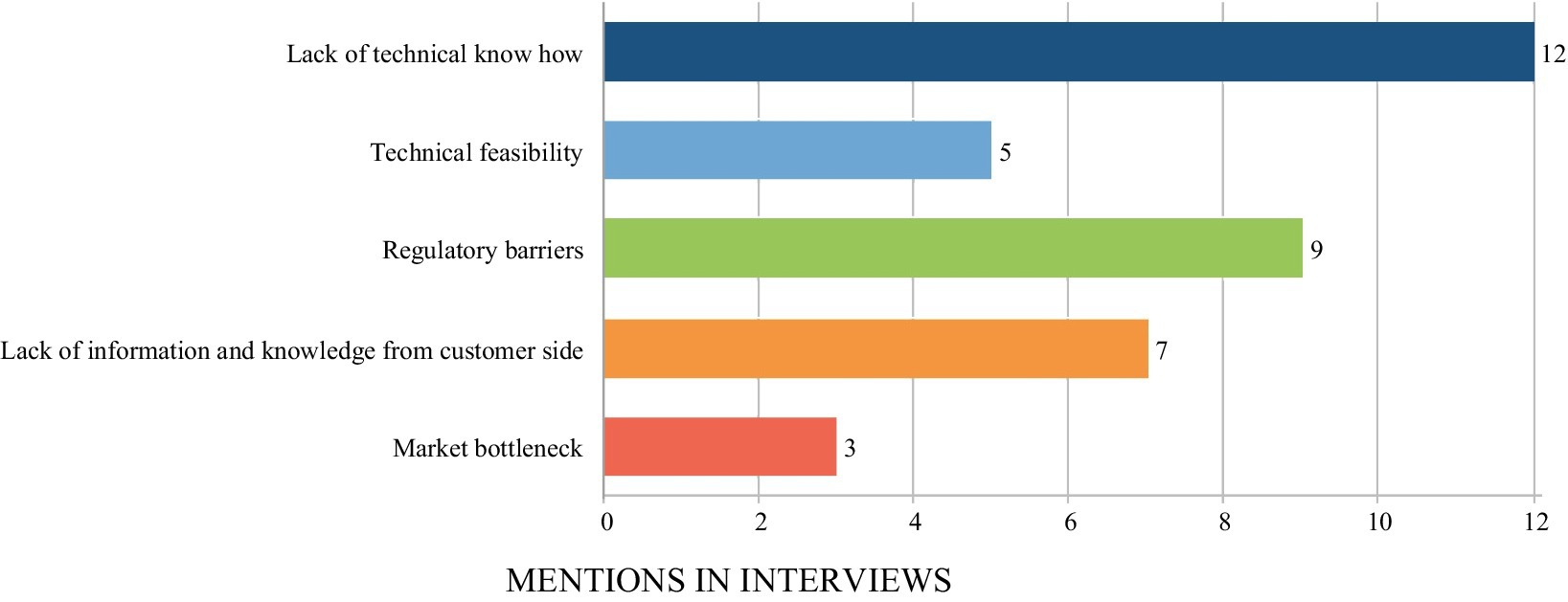
Figure 4. Main barriers of large heat pump in MFHs identified from the responses and frequency of their mentions.
Technical feasibility summarizes several aspects that make the implementation of HPs in MFHs difficult. Specific problems are the lack of space for a heat pump system in the building, which in some cases leads to the need to modify the structure of the building; for example, when the ceiling needs to be reinforced to support the weight of the heat pump. These situations can significantly delay and complicate the project.
A lack of know-how on the part of both technical experts and clients is identified. The interviewees recognized that most of the technicians are very familiar with the installation of heat pumps in single-family houses, where the hydraulic is relatively simple and products and procedures are standardized. Nevertheless, as soon as the building gets bigger, a heat pump project becomes much more complex (due to the above-mentioned technical problems), and the installers can no longer do the whole work by themselves.
Additionally, house owners are not aware that heat pumps can be a good solution for MFHs. There is a lot of uncertainty regarding the technology which might delay their decision process.
Furthermore, the installation of heat pumps is subject to several regulations such as noise insulation, and aesthetic rules. Several interviewees mentioned that this regulation varies greatly from city to city, making it difficult to replicate projects in different cities. The cantonal harmonization of the regulations can facilitate the standardization of the heating systems. Table 2 summarizes the most relevant barriers.
4.2.2 Contracting business model
The second part of the interview focused specifically on the contracting business model. First, looking at the possible barriers. Second, asking about the possible actors interested in providing contracting solutions. Finally, looking for the key activities and resources for its successful implementation.
4.2.2.1 Barriers and risks of the contracting business model
According to our interviewees, the most prominent barriers and risk for a contracting business model are the large transaction cost, the customer acceptance and the tariff estimation risk (see Figure 5).
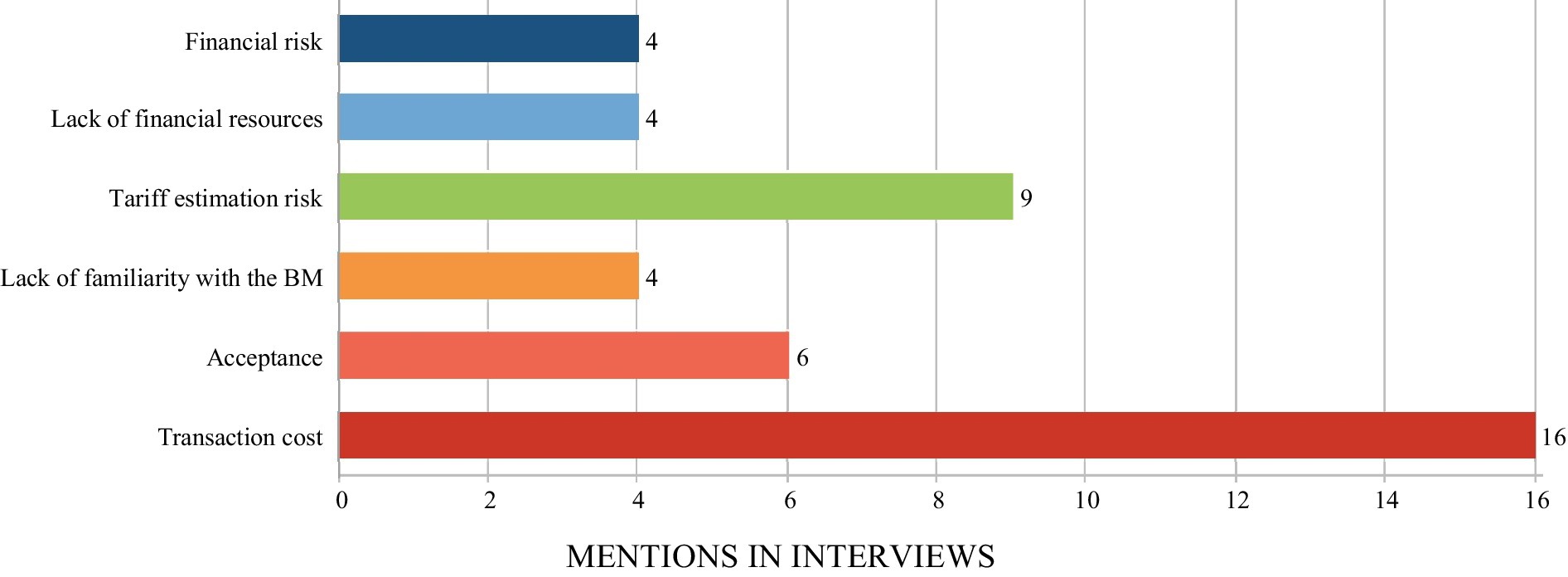
Figure 5. Main barriers of the contracting business model for HPs in MFHs identified from the responses and frequency of their mentions.
The transaction cost was often mentioned as one of the reasons why small and medium enterprises (SMEs) in the heating and cooling industry, are not interested in providing contracting solutions (R_02, T_03). Particularly problematic is that contracting requires not only a technical know-how, which is intrinsic in this industry, but also legal know-how. Regarding customer acceptance, the interview participants mentioned two main factors: first, the long duration of the contract and second, most respondents from real estate companies emphasize that clients perceive contracting as a very expensive solution (I_01, I_02, I_03; Table 3).
Our interview partners consider that the highest risk for contracting is the heating tariff estimation risk. This relates to the fact that the heating tariff must be calculated in advance and is subject to large uncertainty on the realization of the project (T_03). This might lead to unfavorable conditions for the involved parties (the contractor and/or the client; E_01). This might not only undermine the acceptance of the contracting business model (e.g., T_03), but can tie the contractor to an unprofitable contract yearslong (e.g., E_01). Contrarily, the default risk was considered low for the same reasons mentioned by Klinke et al. (2017), even if the original occupant moves out or the client becomes insolvent, another occupant will likely move into the building and take over the ESCO contract.
4.2.2.2 Companies potentially interested in offering contracting solutions
The interviewees were asked about which kind of companies are offering or interested in offering energy supply contracting. Here, public oriented companies are mentioned most often as summarized in Figure 6.
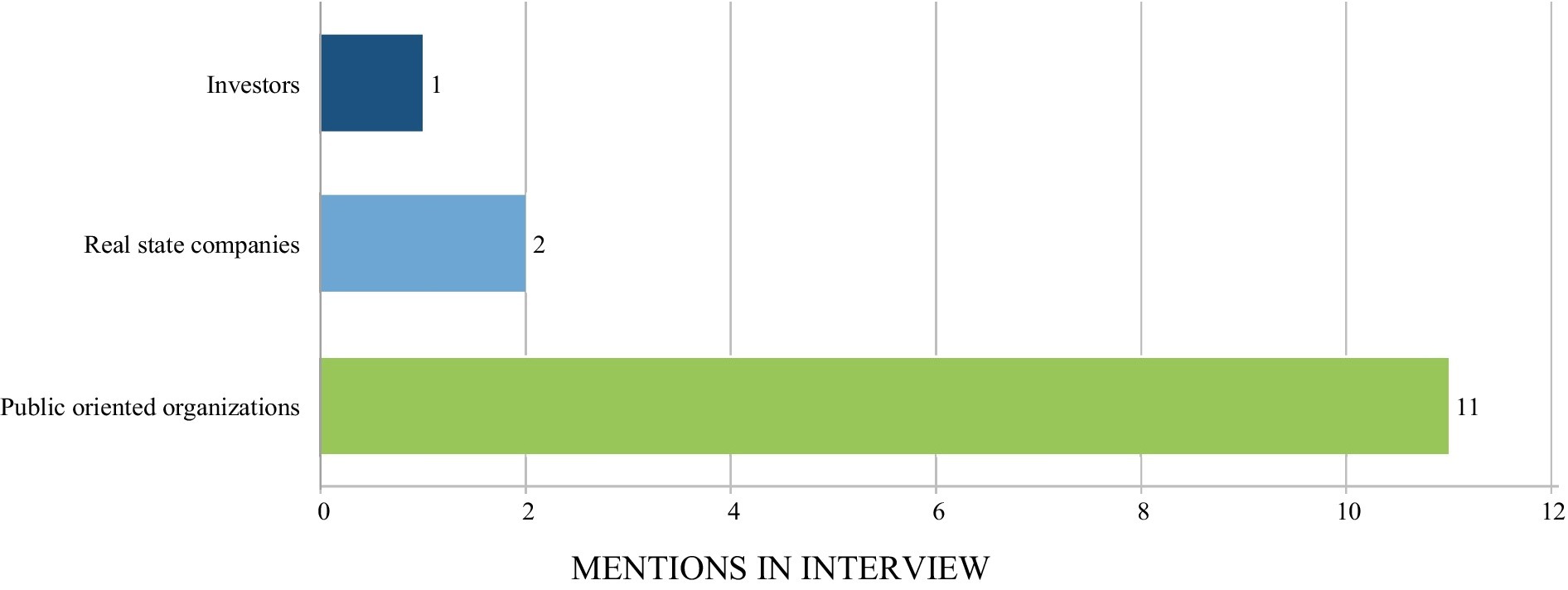
Figure 6. Companies offering or interested in offering contracting solutions from the responses and frequency of their mentions.
The reason for this is that energy supply contracting is a capital-intensive business model. Public organizations have in general easy access to capital at good conditions, unlike private companies, which makes the competition for the latter very hard.
Some of the interviewees mentioned that real estate companies would be interested in contracting. Therefore, we asked representatives of these companies. In their view, contracting is not an attractive business model for them, for two reasons: firstly, a contracting business model has a completely different risk profile than the typically low-risk real estate business and secondly heat contracting is not part of the core activities of real estate companies, so compliance with the contract by providing heat at all times, even in cases where the system is out of order, would be difficult and economically unattractive (I_03).
“I can imagine that real estate companies are not so interested in offering contracting, because (…) you are then responsible for this facility and have to fulfil and set up your part of the contract, and there are other companies that are probably much better organized than a real estate company in terms of on-call and emergency services and so on” (Translation from: I_03).
4.2.2.3 Success factors for a contracting solution
Based on the answers of the interviews we have identified several aspects that can contribute to the success of an energy contracting solution.
Timely sensitization of the customers is key for the successful planning and realization of the heating system replacement. The installation of a HP in a MFH requires longer planning times than simple replacing the old heating system with a new fossil boiler. If the customer is not aware of this and plans to wait until the current heating system must be replaced, several difficulties may appear and installing a renewable heating alternative might be hampered further. Therefore, it is advisable to actively contact building owners whose heating systems are older than 15 years and encourage them to perform an energetic assessment of their building (P_01). In addition, it was stated that different strategies should be employed to reach distinct customer types. For instance, digital affine customers can be addressed through internet tools whereas, non-digital-affine customers need face-to-face contact, which can be provided at energy meetings organized by communities” (Translation: H_01).
A thorough energetic assessment should consider not only the fuel change but all possible renovation options that can easily help to reduce heat demand (e.g., facade insolation, improving windows etc.) and that can be implemented before the new heating system is planned (e.g., R_02).
In addition, transparency is seen as one of the most important aspects; customers should have enough information about the needs of their buildings and be able to understand the cost structure.
Regarding the planning process, a preliminary monitoring of the current heating system was mentioned as a crucial aspect for the well-functioning of the energy supply contracting. This monitoring should last at least 6 months and should be performed during the heating season. The goals are to get to know the building, collect data that helps to correctly dimension the heat pump system and establish the baseline to calculate the effective energy savings in case energy performance contracting is offered. The data availability will at the same time reduce the heating tariff estimation risk.
During the operation phase, monitoring of the new heating system was highlighted as crucial in several responses (e.g., T_02, E_01). Monitoring can help on the one side, the installers, and technicians to find out if there are problems in the installation and rapidly identify where (T_03); on the other side, it can improve the transparency of the project by enabling the collection of real consumption data, while facilitating maintenance (E_01).
5 Discussion
In this section, we used the business ecosystem framework to structure the discussion of our insights from the literature review and expert interviews. We summarized our findings in a Theory of Change matrix which clearly show an actionable plan for the different stakeholders in the business ecosystem. Finally, we analyzed the dynamic phases of ecosystem transformation, highlighting the activities that the PPP can undertake to accelerate the transformation of the HP ecosystem.
5.1 Public and customer value proposition
The contracting business model for HPs in MFHs has a dual value proposition that includes both public and private benefits. The public value proposition is related to the reduction of CO2 emissions through the decarbonization of heating systems in MFHs, whereas the customer value proposition is associated with the financial accessibility. It facilitates the installation of a heat pump system without imposing high upfront costs, while reducing both the financial and technical risk. This public and private value proposition alignment provides the legitimation for setting up a public private partnership or the involvement of public authorities in orchestration activities in support of HPs diffusion in MFHs.
5.2 Orchestration
In the context of ecosystem governance, orchestration plays a pivotal role. The primary responsibility of an orchestrator is to effectively coordinate activities among the diverse actors (Lewrick, 2022; Paasi et al., 2023). The interview results provide evidence that the public entity should be responsible for the orchestration of the ecosystem. As depicted in Figure 2,this includes in our case offering the contracting solution directly, because energy contracting present larger difficulties for other market players, including access to capital and high transaction costs. Additionally, as also mentioned in Pätäri and Sinkkonen (2014) it requires a wide range of skills. These include not only technical know-how, but also administrative and legal skills which are usually present in large companies. In summary, in order to align public objectives with those of private companies, the public actor would take on the role of the contractor, but can still promote market development by subcontracting private actors, for example as installers and designers, and by carrying out other activities that will be further explained in section 5.4.
5.3 Common resources
We have identified the common resources necessary for the well-functioning of a contracting business model. Figure 7 differentiates six categories: the most important physical resources are standardized HPs for MFHs. So far large HPs have been used in the industry and therefore, they do not fully meet all requirements for residential use, such as noise insulation. Financial resources relate to the capital needed to develop the contracting project, as well as the government subsidies. Data regarding the current heat consumption of the buildings is considered as a very important resource for a successful contracting business. Human resources correspond to the need of building professional with the necessary know how to design and install HPs in MFHs. The social capital refers mainly to awareness and trust in HPs created through the exchange of reliable information with owners and tenants.
5.4 Value network transformation and industrial feedback
The results also provide empirical evidence for a ToC for the transformation of the business ecosystem supporting the diffusion of HPs in MFHs. The indicated resources as input are linked to activities and the corresponding project-output, and -outcome as well as societal long term impact (Mattos et al., 2022). The industrial activities within the value network, contribute to the creation of the necessary resources, while simultaneously reducing the risks for the contractor.
Figure 8 depicts the ToC and summarizes the activities and resources required from the ecosystem actors not only to successfully operate a contracting solution, but also to accelerate the adoption of HPs in MFHs. These activities are relevant to the success of both contracting business model designs studied.
Primarily, activities are required to generate the necessary know-how and achieve the required standardization of the large heat pumps in MFHs. The harmonization and facilitation of HPs regulation between different cantons by the central government would also be a contribution to standardization and mitigation of the regulatory risk.
Furthermore, as mentioned by Schmid et al. (2023) it is very important for municipalities to identify buildings with high renovation / fuel change potential. In this way, the right owners can be addressed timely and receive trustworthy information regarding the necessary measures (Lanz and Reins, 2021). Providing information and events can be part of the activities carried out by the PPP.
As discussed before, it is reasonable that the public entity takes the lead on providing contracting business models for HPs in MFHs, because other market participants lack of the simultaneously necessary technical and administrative skills and the capital to offer this business model. Additionally, the public entity may have already established a relationship with the customers, for example, in its role as a public utility, which might increase acceptance and reduce transaction cost (Côté and Pons-Seres de Brauwer, 2023). Likewise, the collaboration of the public entity with building professionals in the planning, monitoring, installation, and maintenance of the heat pumps will increase know-how sharing supporting market growth further.
During the design and planning phase the preliminary monitoring is extremely important to estimate the actual heating need of the building. This not only reduces the design risk but at the same time facilitates the estimation of the heat tariff reducing the financial risk. During the operation, correct monitoring of the heating system will not only facilitate the maintenance and increase transparency but also provide data that can improve building simulations and enables the further development of digital tools, which in the long term will help to tackle the design risks (Britton et al., 2021).
Last but not least, it becomes also important to train the user in the proper use of the new heating system to reduce underperformance due to poor building operation practice as highlighted by Cozza et al. (2021), reducing the behavioral risk.
5.5 Transformation of the HP business ecosystem
The dynamic transformation of the HP ecosystem is analyzed using the framework developed by Laakkonen et al. (2023) and Möller et al. (2020). The framework illustrates the activities that the PPP can undertake to influence the transformation of the HP ecosystem (see Figure 9).
It can be observed that the traditional value creation model of the heating industry is being challenged by several policies that prohibit the use of fossil fuels in residential buildings.
The first activity that the PPP should perform is to acquire strategic knowledge, as mentioned in section 5.4, this can be done through the participation in pilot projects, with the objective of demonstrating the technical and economic feasibility of heat pumps in MFHs and in this way as suggested by Möller et al. (2020) reduce the perceived risk.
In this stage of the process, data on the condition of the buildings and the owners is of the utmost importance. It is necessary to identify and contact those likely to be early adopters, which may include public buildings or professional real estate investors with a high level of self-interest. These groups can serve as a testing ground for the business model in a subsequent phase.
The results of our study indicate that the public actor should assume the role of an orchestrator, applying a contractor BM; the public authority assumes the entire up-front cost and retains ownership of the assets, reducing the risk of the customers.
Moreover, as previously stated, the participation in activities that lead to the standardization of HPs installation in MFHs and the harmonization of regulation is of paramount importance. Standardization, helps to stabilization of the ecosystem in the long run (Möller et al., 2020; Figure 9).
6 Conclusions and further work
The objective of this paper was to address the following research questions: How can public and private actors create or transform a business ecosystem to facilitate the adoption of HP systems in MFHs? Which business model designs, resources and activities are most helpful to perform this (trans)formation?.
Through literature review, we identified contracting as a promising business model to overcome several barriers to HP adoption in nonrenovated MFHs, especially the high upfront cost. We proposed two distinct contracting designs that differ in the role played by the public authority. In the first, the public authority assumes the role of the contractor, and in the second, it acts as a facilitator to ease contracting solutions provided by private companies.
We conducted several interviews and employed an ecosystem perspective to gain a comprehensive understanding of the evolution of the HP market in MFHs as well as to validate the two studied contracting business models designs.
We found that private companies face several challenges in offering a contracting business model for HPs in MFHs. These challenges include not only limited access to capital but also the high transaction costs associated with this business model. Based on these findings, we conclude that it makes sense for the public actor to act as a contractor, at least until the HP market in MFHs reaches stabilization.
Additionally, we emphasize that the successful operation of a contracting business model, as well as the acceleration of heat pump adoption in MFHs, requires coordinated efforts and resources from various stakeholders. This includes raising customer awareness, disseminating know-how among the technical workforce, standardizing processes, providing financial support.
Carrying out these activities will contribute to the (trans)formation of the business ecosystem until a stabilization is reached. At this point the public actor might reconsider the need to maintain asset ownership or explore the implementation of a buy-back mechanism to transfer ownership. The stabilization phase, however, was not addressed in this paper and therefore requires further investigation.
Furthermore, it is suggested to analyze in detail the decision making and implementation process of running fuel-switch projects, with focus on responsibilities, costs, risks, and information flow. Based on such an empirical analysis, business model testing and adjustments for the PPP is supported.
Data availability statement
The raw data supporting the conclusions of this article will be made available by the authors, without undue reservation.
Author contributions
JZ: Conceptualization, Formal analysis, Visualization, Writing – original draft, Writing – review & editing. JG: Conceptualization, Funding acquisition, Writing – review & editing. SU-B: Conceptualization, Funding acquisition, Investigation, Supervision, Writing – review & editing.
Funding
The author(s) declare that financial support was received for the research, authorship, and/or publication of this article. This research was financially supported by the Swiss Innovation Agency Innosuisse, through the Flagship Initiative, Project “RENOWAVE” (www.renowave.ch). Open access funding by Zurich University of Applied Sciences (ZHAW).
Conflict of interest
The authors declare that the research was conducted in the absence of any commercial or financial relationships that could be construed as a potential conflict of interest.
Publisher’s note
All claims expressed in this article are solely those of the authors and do not necessarily represent those of their affiliated organizations, or those of the publisher, the editors and the reviewers. Any product that may be evaluated in this article, or claim that may be made by its manufacturer, is not guaranteed or endorsed by the publisher.
References
Backlund, S., and Thollander, P., (2011). The energy service gap: what does it mean? Presented at the European Council for an Energy Efficient Economy (ECEEE), Stockholm Sweden. pp. 649–656.
Britton, J., Minas, A. M., Marques, A. C., and Pourmirza, Z. (2021). Exploring the potential of heat as a service in decarbonization: evidence needs and research gaps. Energy Sourc. Part B Econ. Plan. Policy 16, 999–1015. doi: 10.1080/15567249.2021.1873460
Brown, D., Hall, S., Martiskainen, M., and Davis, M. E. (2022). Conceptualising domestic energy service business models: a typology and policy recommendations. Energy Policy 161:112704. doi: 10.1016/j.enpol.2021.112704
Côté, E., and Pons-Seres de Brauwer, C. (2023). Preferences of homeowners for heat-pump leasing: evidence from a choice experiment in France, Germany, and Switzerland. Energy Policy 183:113779. doi: 10.1016/j.enpol.2023.113779
Cozza, S., Chambers, J., Bolliger, R., Tarantino, M., and Patel, M. K. (2022). Decarbonizing residential buildings with heat pumps: transferability of front-runner experiences from Swiss cantons. Energy Rep. 8, 14048–14060. doi: 10.1016/j.egyr.2022.09.141
Cozza, S., Chambers, J., Brambilla, A., and Patel, M. K. (2021). In search of optimal consumption: a review of causes and solutions to the energy performance gap in residential buildings. Energ. Build. 249:111253. doi: 10.1016/j.enbuild.2021.111253
European Commission (2020). Renovation wave: doubling the renovation rate to cut emissions, boost recovery and reduce energy poverty. Available at: https://ec.europa.eu/commission/presscorner/detail/en/ip_20_1835
Farsi, M., Jakob, M., Weber, S., and Maciosek, B., (2022). Motivations for Investment in Smart Technologies and Energy Efficiency. Swiss Federal Office of Energy SFOE. Available at: https://www.tep-energy.ch/docs/p1112_221219_MISTEE_Finalreport_combined_UniNE_TEP_V3.6.1_sent.pdf
Fraga, C., Hollmuller, P., Schneider, S., and Lachal, B. (2018). Heat pump systems for multifamily buildings: potential and constraints of several heat sources for diverse building demands. Appl. Energy 225, 1033–1053. doi: 10.1016/j.apenergy.2018.05.004
Freyre, A., Cozza, S., Rüetschi, M., Bürer, M., Sahakian, M., and Patel, M. K. (2021). How to improve effectiveness of renewable space heating programs by better understanding homeowner—installer interactions. Energies 14. doi: 10.3390/en14154625
Kircher, K. J., and Zhang, K. M. (2021). Heat purchase agreements could lower barriers to heat pump adoption. Appl. Energy 286:116489. doi: 10.1016/j.apenergy.2021.116489
Klinke, S., Reiter, U., Farsi, M., and Jakob, M. (2017). Contracting the gap: Energy efficiency investments and transaction costs. Neuchâtel, Switzerland: Bundesamt Für Energ.
Koskela-Huotari, K., Edvardsson, B., Jonas, J. M., Sörhammar, D., and Witell, L. (2016). Innovation in service ecosystems—breaking, making, and maintaining institutionalized rules of resource integration. J. Bus. Res. 69, 2964–2971. doi: 10.1016/j.jbusres.2016.02.029
Koutsandreas, D., Kleanthis, N., Flamos, A., Karakosta, C., and Doukas, H. (2022). Risks and mitigation strategies in energy efficiency financing: a systematic literature review. Energy Rep. 8, 1789–1802. doi: 10.1016/j.egyr.2022.01.006
Laakkonen, A., Rusanen, K., Hujala, T., Gabrielsson, M., and Pykäläinen, J. (2023). Implications of the sustainability transition on the industry value creation logic – case of Finnish pulp and paper industry. Silva Fenn. 57. doi: 10.14214/sf.23024
Lanz, B., and Reins, E. (2021). Asymmetric information on the market for energy efficiency: insights from the credence goods literature. Energy J. 42, 91–110. doi: 10.5547/01956574.42.4.blan
Lehmann, M., Hess, A., Tschannen, A., and Föhn, Z., (2023). MFH-Heizungsersatz: Heizungsersatz in Mehrfamili-enhäusern von privaten, nicht-institutionellen Eigentümerschaften. Available at: https://www.aramis.admin.ch/Texte/?ProjectID=47562
Lewrick, M. (2022). Design thinking for business growth: How to design and scale business models and business ecosystems. Design Thinking Series: Wiley.
Mattos, C. A., Scur, G., and Albuquerque, T. L. M. (2022). Evaluation of circular business model: theory of change approach. Eval. Program Plann. 92:102069. doi: 10.1016/j.evalprogplan.2022.102069
Möller, K., Nenonen, S., and Storbacka, K. (2020). Networks, ecosystems, fields, market systems? Making sense of the business environment. Ind. Mark. Manag. 90, 380–399. doi: 10.1016/j.indmarman.2020.07.013
Montero, O., Brischoux, P., Callegari, S., Fraga, C., Rüetschi, M., Vionnet, E., et al. (2022). Large air-to-water heat pumps for fuel-boiler substitution in non-retrofitted multi-family buildings—energy performance, CO2 savings, and lessons learned in actual conditions of use. Energies 15. doi: 10.3390/en15145033
Moore, J. F. (2006). Business ecosystems and the view from the firm. Antitrust Bull. 51, 31–75. doi: 10.1177/0003603X0605100103
Paasi, J., Wiman, H., Apilo, T., and Valkokari, K. (2023). Modeling the dynamics of innovation ecosystems. Int. J. Innov. Stud. 7, 142–158. doi: 10.1016/j.ijis.2022.12.002
Pätäri, S., and Sinkkonen, K. (2014). Energy service companies and energy performance contracting: is there a need to renew the business model? Insights from a Delphi study. J. Clean. Prod. 66, 264–271. doi: 10.1016/j.jclepro.2013.10.017
Perch-Nielsen, S., Koller, L., Steverlynck, D., and Müeller, M., (2023). Grundlagen zur Ausgestaltung Impulsprogramm für Wärmeerzeugerersatz und Energieeffizienz (KlG) und Weiterentwicklung des Gebäudeprogramms nach Art. 34 CO2-Gesetz.
Pezzutto, S., Grilli, G., and Zambotti, S. (2017). European heat pump market analysis: assessment of barriers and drivers. Int. J. Contemp. Energy 3, 62–70. doi: 10.14621/ce.20170207
Schmid, C., Wegmüller, F., Mahler, M., and Bufler, R., (2023). Sanieren beschleunigen Leitfaden für eine höhere Sanierungsrate.
Shen, L., Shi, Q., Parida, V., and Jovanovic, M. (2024). Ecosystem orchestration practices for industrial firms: a qualitative meta-analysis, framework development and research agenda. J. Bus. Res. 173:114463. doi: 10.1016/j.jbusres.2023.114463
Speich, M., and Ulli-Beer, S. (2023). Applying an ecosystem lens to low-carbon energy transitions: a conceptual framework. J. Clean. Prod. 398:136429. doi: 10.1016/j.jclepro.2023.136429
Trier, D., Kowalska, M., Paardekooper, S., and Volta, J., (2018). Business cases and business strategies to encourage market uptake. Available at: https://planenergi.eu/wp-content/uploads/2023/09/Business-cases-and-business-strategies-to-encourage-market-uptake.pdf
Van Bockhaven, W., and Matthyssens, P. (2017). Mobilizing a network to develop a field: enriching the business actor’s mobilization analysis toolkit. Ind. Mark. Manag. 67, 70–87. doi: 10.1016/j.indmarman.2017.08.001
Vanstraelen, L., Marchand, J., and Casas, M., (2015). Increasing capacities in cities for innovating financing in energy efficiency (Cityinvest). Available at: http://citynvest.eu/sites/default/files/library-documents/20151202_WP2_Final_Report-V1.5.PDF
VMWG (2020). Verordnung über die Miete und Pacht von Wohn- und Geschäftsräumen, 6a. Available at: https://www.fedlex.admin.ch/eli/cc/1990/835_835_835/de
Wan, S., Liu, Y., Ding, G., Runeson, G., and Er, M. (2023). Risk allocation for energy performance contract from the perspective of incomplete contract: a study of commercial buildings in China. Int. J. Clim. Change Strateg. Manag. 15, 457–478. doi: 10.1108/IJCCSM-11-2021-0130
Annex
TABLE 1 Interview partner overview.
Keywords: heat pumps, building decarbonization, contracting, business models, business ecosystem
Citation: Zapata Riveros J, Gallati J and Ulli-Beer S (2024) Mitigating risks and breaking barriers, energy supply contracting in multifamily houses: an ecosystem perspective. Front. Sustain. Cities. 6:1460960. doi: 10.3389/frsc.2024.1460960
Edited by:
Roberto Alonso González-Lezcano, CEU San Pablo University, SpainReviewed by:
Fernando Del Ama Gonzalo, Keene State College, United StatesMaría Eugenia Maciá, CEU San Pablo University, Spain
Copyright © 2024 Zapata Riveros, Gallati and Ulli-Beer. This is an open-access article distributed under the terms of the Creative Commons Attribution License (CC BY). The use, distribution or reproduction in other forums is permitted, provided the original author(s) and the copyright owner(s) are credited and that the original publication in this journal is cited, in accordance with accepted academic practice. No use, distribution or reproduction is permitted which does not comply with these terms.
*Correspondence: Juliana Zapata Riveros, SnVsaWFuYS56YXBhdGFAemhhdy5jaA==
 Juliana Zapata Riveros
Juliana Zapata Riveros Justus Gallati
Justus Gallati Silvia Ulli-Beer
Silvia Ulli-Beer
